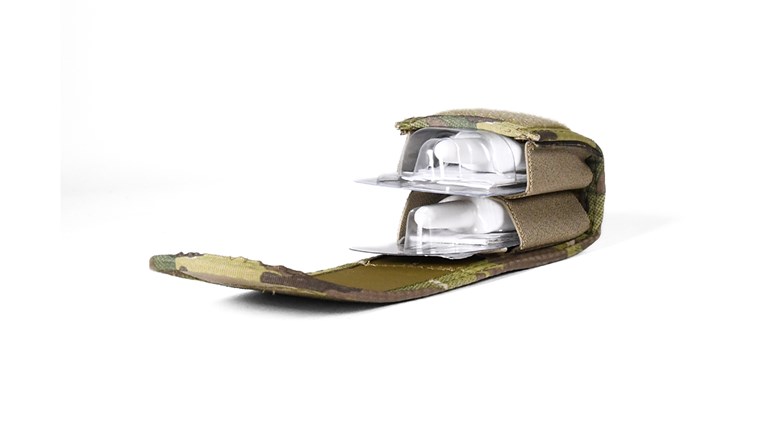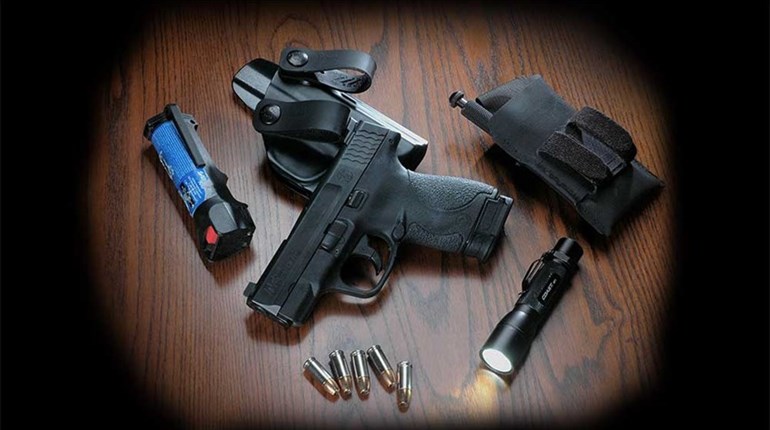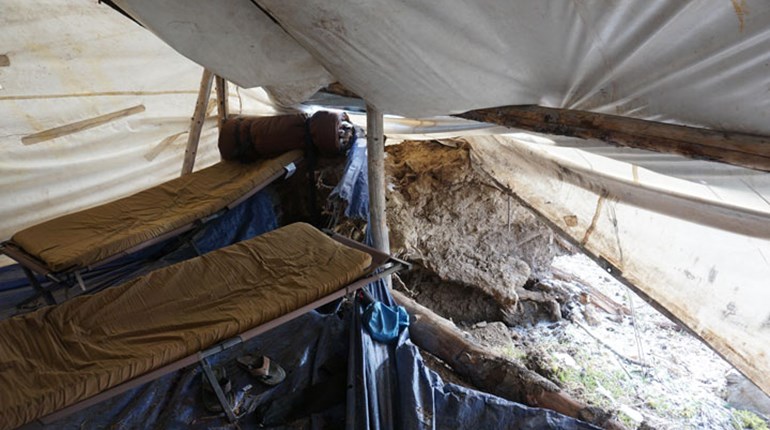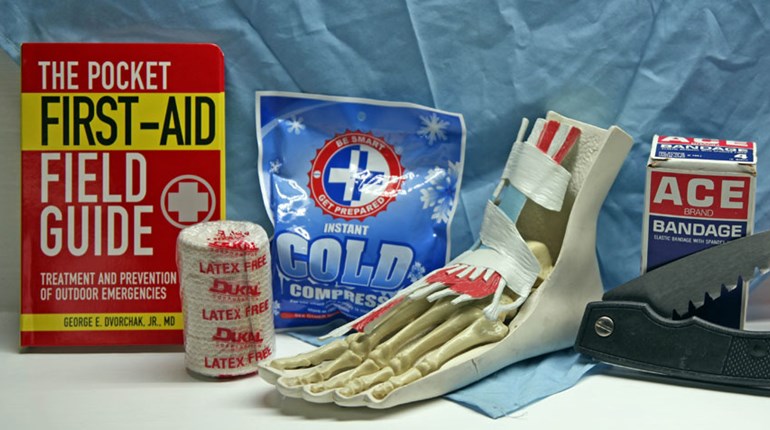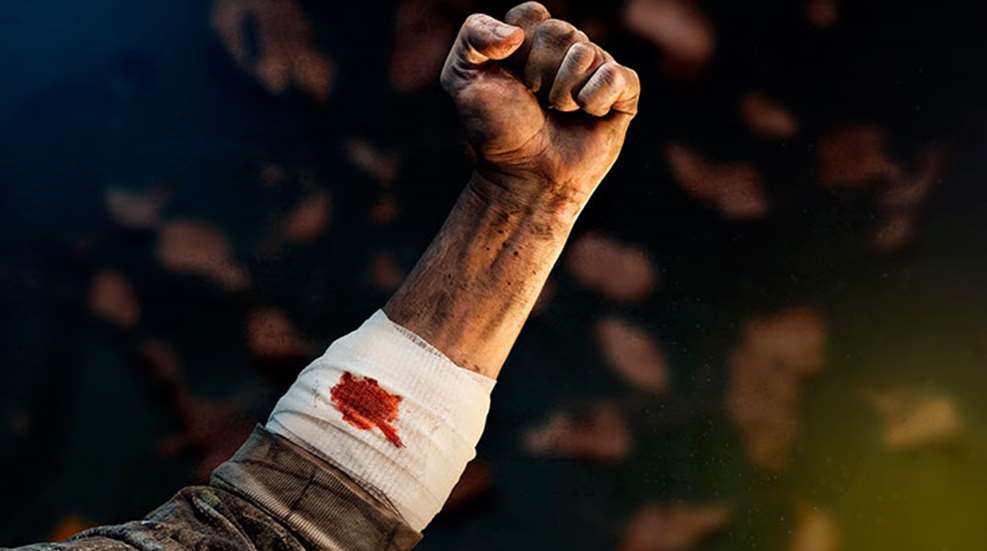
Sheep hunting is hard and you are tired. But as you make your way along the narrow trail, the horns lashed to your backpack lift the fatigue off your shoulders. You saved for years and worked a lot of overtime to fund this trip. It might be an overused phrase, but this truly has been the trip of a lifetime and worth everything it took to get here.
Your guide turned out to be a great guy, lots of fun and a damn good hunter. He is just as tired as you are, maybe even more so as this is the third sheep hunt of the season for him. He has talked a lot about how much he is looking forward to getting home and seeing his wife and kids.
The cold rain has turned to sleet, and it is starting to collect on the ground. Footing is getting a bit treacherous as you hurry to get down off this mountain and back to the tent camp 1,500 vertical feet and several miles below.
You hear a shout and look up to see your guide pitching over the side of the trail. You look on in horror as he falls 15 feet straight down before he hits the rocks below and starts to tumble down the slope. He makes several flips, looking like a twisted rag doll before he collides with a big boulder and stops.
He isn’t moving and you can see blood staining the wet snow around him. You yell at him again and again, but he doesn’t respond. The adrenaline is pumping and you can feel the edges of panic setting in, but you know you have to help him. It seems like it’s taking hours to find a safe path down, but your watch says it’s only been 30 minutes since you last checked it. But is this the second time you looked? It’s so hard to think.
When you get to him he is breathing but unconscious and not responsive to your voice. He is bleeding from a gaping wound in his head and from his leg where it looks like he has an extra knee. The shin bone is poking through his blood-soaked pants, he is soaking wet and is starting to shiver uncontrollably.
Your satellite phone is in the tent. There is no help for miles. It’s all on you. What you do in the next few minutes and in the next several hours will determine if this guy lives to hunt again or if his body will be carried off this mountain, cold and stiff.
The above situation is a very real emergency made even worse by the remote location, but don’t think you’ll never have to respond to a life-threatening accident if you only hunt close to home. Maybe it’s midweek and you ducked out of work an hour early so you can get in a little deer hunting. You are walking into your stand when you think you hear something. You stop, stand very still, holding your mouth open to aid your hearing, and listen.
There it is again—a faint cry for help.
You follow the sound, yelling back to keep the responses coming, and a few hundred yards through the woods you come to a big maple tree with a stand 20 feet off the ground. Underneath, crumpled into an impossible position, is your neighbor. He is panicked and keeps screaming that he can’t feel his legs, even though they are both clearly broken.
You pull out your cell phone to call 911, and as you expected, there is no signal. You can’t leave him here, lying on the wet ground. His face is in a puddle of water, and he struggles to hold his head up high enough to breathe. You know that you have to go at least a mile to find a cell signal, but he may drown if you don’t get him out of that puddle. But you also know that moving him when he has an obvious spinal injury could cause a lot more damage.
Your actions will not only help save his life, but may make the difference if he will ever walk again. Do the wrong thing, and you can paralyze or even kill him. But you can’t just do nothing. It’s on you to help this guy, and you are not the kind of person who walks away from responsibility.
Prepare for the Worst
We don’t often think about it, but hunting can be a dangerous sport. We climb high into trees, hike steep mountains and traverse unknown terrain, often in the dark. We use boats, canoes, ATVs, trucks, horses or snowmobiles and take them far off the paved roads. We build open fires and expose ourselves to wild animals, poisonous snakes and swarms of bees. We handle sharp knives, chainsaws, broadheads, firearms, gasoline and other potentially dangerous goods. Often we do all this in horrible weather and in remote locations. When somebody gets hurt, help is not minutes away as it is in an urban setting, but more like hours or even days.
Hunters tend to be self-sufficient people with great problem-solving skills. But those skills are only as good as our knowledge and training. The scenarios I described above require more than just a can-do attitude to result in a good outcome. If you are going to save these people you need knowledge of first aid that goes beyond the basic class you took at work last year. Such classes are predicated on the assumption that help is just a few minutes away. They teach you to stop the bleeding, make the patient comfortable and wait for the professionals. What they lack is the information and training needed to deal with a major, life-threatening event when the professionals are hours or possibly days away.
So how does a hunter go about learning these things? I am not aware of any organization that teaches advanced wilderness first-aid courses specifically for hunters. However, there is another group of outdoor enthusiasts who share the same love of wilderness and are very serious about training.
The outdoor-adventure industry is composed of mountain and rock climbers, backpackers, trekkers, mountain bikers, kayakers, etc. While they may differ from hunters in several philosophical areas, they share our love of wilderness and the outdoors. They often run organized backcountry trips for groups and approach their sports with a strong sense of community. Heck, they even have university programs devoted to these sports. (I wish there was a graduate-level program in deer hunting; you might be calling me “Doctor Towsley” by now.) The instructors and leaders of these groups are serious about first aid and rescue, and have multiple programs devoted to teaching these skills.
These courses are oriented to the outdoor adventure sports, and so some of the scenarios they cover are different from what we do as hunters. But the basics are very similar and the injuries they address are the same as we often see in hunting accidents. It probably doesn’t matter if you fall out of a treestand or off a boulder you are climbing. If you wreck a bicycle or a 4-wheeler, the injuries are the same.
The courses often deal with falls from heights, tumbling falls and the resulting injuries. Those include broken bones, head and spinal injuries, cuts, sprains, abrasions, punctures or impalements. They also deal with the problems common to all outdoor situations such as burns, adverse allergic reactions to insect stings, heat exhaustion/heat stroke, hypothermia, frostbite and even heart attacks. In other words, pretty much the same problems we hunters may encounter.
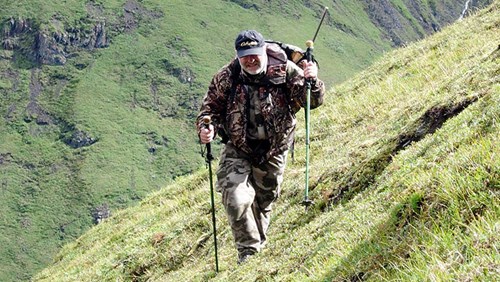
Learn From an Expert
John Kascenska has a Ph.D. in outdoor recreation and is certified in so many things relating to outdoor first aid and rescue that just writing them down would make a book. (Full disclosure: He is also my wife’s brother.) When Kascenska took an early semi-retirement from his administrative position at one of the Vermont State Colleges and expanded his company teaching SOLO Wilderness First Aid and Wilderness First Responder courses, I decided that I needed to brush up on a few things.
SOLO, or Stonehearth Open Learning Opportunities, was founded in 1976 by Dr. Frank Hubbell. It is the oldest continuously operating school of wilderness medicine in the world, with a campus in Conway, N.H. Courses developed by SOLO are taught around the world.
I have always had the mindset that I should depend on no one but myself in any hunting situation. If you assume the worst, you are never disappointed or unprepared. My mindset is I should be prepared to deal with any problem and be able to save myself or my guide in a bad situation. The guide in my earlier hunt scenario may be an emergency room doctor in the offseason, but that is not going to save him when he’s unconscious. Unless the hunter can deal with the problem, it’s going to end badly.
One area where I recognized my weakness is in first aid. Like a lot of people, I completed several work-related courses. But that was many years ago. I also read a lot of books, but they only taught me so much. I even used those skills in emergency situations a few times over the years, but I knew they were now out of date and far too rusty to be dependable. Plus, there were some areas where I just didn’t have a clue.
So I enrolled in a two-day SOLO Wilderness First Aid course, expecting to learn how to deal with cuts, burns, stings and maybe a sprained ankle or even a broken arm. I was shocked to find out my expectations were all wrong. We learned all that, of course, but we also covered a lot of things I had not anticipated.
See the Big Picture
Much of the first day was spent on assessing and identifying injuries, evaluating patients and analyzing situations. With help so far away, priorities change. For example, the concept of stabilize and transport will mean one thing in the civilized world and entirely another in the wilderness. In the wilderness, transport might be many hours or days away. Or you might be the transport.
I am a jump-in-and-get-started kind of guy, but after completing several role-playing scenarios in which I had to deal with injured people, I came to realize that’s not always best. You must deal with the life-threatening things first, but you need to be aware of all the potential injuries not readily seen when first responding.
For example, suppose you came upon a guy lying on the trail after a fall. He is bleeding from a gash on his head. Of course, the first thing most of us will do is dive in and stop the bleeding. But what if he has a spinal injury? What if he has a broken rib that has punctured his lung? Moving him the wrong way can compound his injuries. So, a careful head-to-toe evaluation is necessary. If the bleeding is life threatening, deal with it as you evaluate, but go through the process to make sure you fully understand what you are dealing with before you make any rash decisions.
Patient and situational evaluation are very important. Maybe you are so focused on the ugliness of a compound fracture that you fail to notice the patient is not breathing. Or how about your neighbor who fell out of his treestand? The first impulse will be to move him to a safe place while you go for help. But that could compound his injuries. There are methods to properly move someone who has fallen from height; you need to know how to do that, but first you also need to be able to recognize the extent of the injuries, including any potential spinal trauma.
A huge part of wilderness first aid is awareness—the ability to see the big picture, and to improvise and use whatever equipment you have to solve the problem. The basic skills of dealing with injuries are of course important, but you need to be able to accurately assess the patient and the situation as well as to prioritize what you need to do and when you need to do it. Then you need to figure out how to do it with what you have available.
I thought this SOLO Wilderness First Aid course would just be an opportunity to polish up some rusty skills and to write an interesting article or two. What it became was a huge wakeup call.
I have been gambling for years and have been lucky enough to beat the odds. I hunt as much as 150 days a year, often in very remote locations, and I have trusted to luck that no one was going to be seriously hurt. Luck was all I had; I sure didn’t have the knowledge or skills to handle an emergency. This epiphany has inspired me to take more advanced courses and to buy a lot of books and videos on this topic. I suggest any hunter consider doing the same. Self-instruction only goes so far; buy the books, but get some professional instruction, too. Luck has a way of running out, and I don’t want to live with the knowledge that a friend or family member died or was damaged for life because I was not informed or skilled enough to help.












